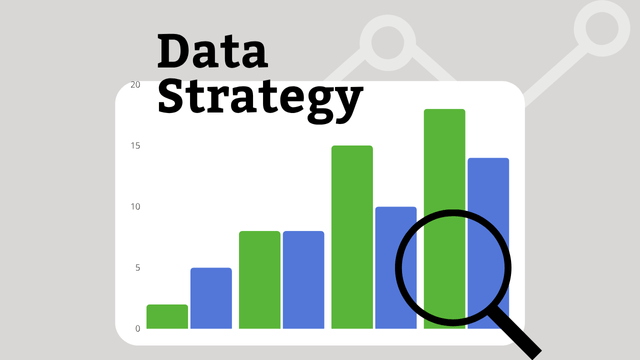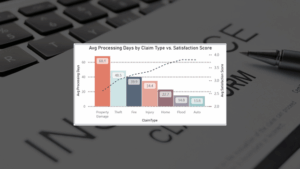Without a clear data strategy, your organization is flying blind. Unfortunately, that’s the reality for many businesses. According to a new study from Carruthers and Jackson, more than a quarter of firms have no formal data strategy.
Ironically, organizations are processing more data than ever, with 64% managing at least one petabyte of data and 41% at least 500. But while data may be abundant, that doesn’t necessarily mean it’s driving value. After all, without a plan to manage, use, and scale all that data, your teams risk making decisions based on assumptions, not facts.
A data strategy is what makes the difference.
In this guide, we cover what a data strategy is, why it matters, and how to implement an effective data strategy that drives real business value.
What is a data strategy?
A data strategy is a structured, long-term plan that defines how your organization will collect, manage, share, and use data to support business objectives and generate measurable outcomes. This includes aligning all the assorted technologies, processes, people, and policies that will come together to turn your data into a strategic asset that powers smarter decision-making to optimize operations and scale with intent.
Notably, a data strategy isn’t just about infrastructure, i.e., choosing analytics tools and figuring out how to source and store data. Instead, a strong data strategy should put the focus on business alignment and what each stakeholder needs to effectively access, understand, and act on data insights.
Why having a data strategy is important (and its benefits)
Intuition may seem like a secret weapon but considering the complexity and volume of decisions today’s businesses face, it’s not the foundation you likely want to bet your business on. Of course, instinct will always play a role in leadership and innovation, but at the end of the day, the truth is in the data.
In this way, a data strategy is a critical framework to ensure your organization can make consistent, confident decisions rooted in the data, not just gut feelings.
Let’s take a closer look at the top 4 benefits of having a data strategy:
1. Improved decision-making
It’s hard to believe, but even in a data-saturated world, most businesses are still making decisions based on a whim. In fact, according to the Sisense 2025 State of Analytics report, a shocking 76% of business leaders “admit they’ve made business decisions without consulting available data because it was too difficult to access.”
This is where a data strategy provides guidance. By helping organizations wrangle their data with governed data pipelines, self-serve reporting tools, and standardized structures, a data strategy establishes a single source of truth to ensure everyone (from top-level, C-suite executives to operational teams) has the easy, on-demand access they need to relevant, timely data to inform their decisions.
2. Better customer insights and experiences
At the end of the day, no matter your industry, all businesses are focused on creating better customer experiences. But if you don’t know who your customers are and what they want, then customer satisfaction becomes little more than a guessing game.
Without integrated, real-time data from customer touchpoints, many organizations are left with only a fragmented view of their audience, leading to generic outreach, mistimed engagement, and other communication fumbles. To better understand customers, a data strategy can help teams connect the dots and turn disparate signals into actionable insights.
For example, research from the University of Maryland Global Campus assesses the role of real-time analytics in patient care and how it helps healthcare organizations enable faster and more informed decision-making that better supports patient outcomes. The same principle applies across industries: Data-driven insights allow you to deliver personalized, timely, and relevant customer experiences.
3. Competitive advantage
There’s a lot of talk these days about becoming a “data-driven” business, but when you look to the numbers, it seems few are actually succeeding at using data to power consistent decision-making.
A new report from Confluent reveals:
- 61% of business leaders “frequently make ‘snap decisions’ without reviewing available data”
- 58% say they rely on “gut feel because it’s too difficult to access insights in real time”
- 84% of executives want to make more data-driven decisions
- 85% believe they “would make better decisions if real-time data was available”
The gap between simply striving to make data-driven decisions and executing on it is increasing. The organizations who learn how to leverage well-designed data strategy to make accurate, real-time decisions will gain a significant competitive advantage to react faster, test smarter, and plan more effectively than their peers.
4. Greater operational efficiency
According to Sean Peek, Senior Analyst at Business.com, “…today’s data is much more complex than the data a typical business was dealing with 20 years ago.”
From APIs to Excel sheets, SaaS platforms, and legacy systems, organizations are dealing with an explosion of structured and unstructured data from dozens of sources, across disconnected systems, with inconsistent formats. Managing all of this data has become a full-time job; without a clear data strategy to integrate, govern, and optimize data flow, teams waste time cleaning spreadsheets or duplicating work.
A data strategy brings operational efficiency to the chaos of modern data. By coming up with a plan to centralize systems, automate manual processes, and give teams reliable access to the timely, relevant data they need when they need it, you can eliminate friction and free up time for higher-value work.
And once that foundation is in place, making decisions from data becomes faster and easier. It’s a win-win: A data strategy helps you use data more efficiently, and then your business operates more efficiently because of it.
How to implement an effective data strategy
Building an effective data strategy takes more than just onboarding new tools and hoping for the best. To create a data strategy that drives lasting impact, you need to strategically align your data efforts with your overarching business goals to ensure they deliver measurable value across your organization.
Just getting started? Follow these seven steps to implement an effective data strategy:
1. Define objectives and requirements
Identify your organization’s key goals. Do you want to reduce churn? Improve forecasting? Optimize marketing ROI?
Every aspect of your data strategy should support these goals. To set the right foundation, collaborate with stakeholders across departments to best understand your teams’ holistic use cases, reporting needs, and success criteria.
2. Assess current data capabilities
Before you can move forward, you need to understand where you’re coming from. Consider: What systems does your organization currently have in place? Where is your data stored? Who owns it?
Take the time to assess your current infrastructure, data quality, reporting processes, and team skillsets. This audit will help you identify gaps to close, redundancies to eliminate, and other opportunities to improve efficiency.
3. Develop a data architecture
Your data architecture should support the flow of data from ingestion to insights. Here, you’ll need to choose the right data storage models (e.g., data lakes, data warehouses, etc.), design ETL pipelines, and implement data modeling tactics that best align with your business goals.
Don’t forget to keep scalability in mind. As you design your data strategy, you want to prepare an architecture that can grow and bend with your organization as your needs, volume, and priorities change with time.
4. Establish governance security protocols
Define roles, responsibilities, and data access policies. Be specific. Consider: Who will own what data? Who will be able to edit it? Who will need read-only access?
A governance framework is a key part of your overall data strategy. It creates guardrails to ensure data quality, protect sensitive information, and reduce risk, while still baking in enough flexibility to allow teams to access and act on data when and where they need it.
5. Build or buy the right tools
Once you’ve determined your main requirements and mapped out your architecture, it’s time to choose the tools to power your data strategy. For example, you may need ETL platforms, BI tools like Power BI or Tableau, or custom dashboards.
Remember, this is not the time to chase trends. Instead, ignore the headlines and what’s popular online and prioritize what’s right for your business. Ask yourself:
- What tools integrate well with your existing tech stack?
- What platforms can scale your growth plans?
- What solutions support both technical and non-technical users?
6. Educate and empower your team
All the careful planning and investment are for nothing if your team never adopts your data strategy.
Provide training, documentation, and support to roll out your new data ecosystem. This training should be accessible for both technical and non-technical members of your team so everyone can understand how to use data in daily operations to make their work better.
7. Monitor and optimize
Finally, remember that your data strategy isn’t a one-and-done project. It’s an ongoing framework that must grow, shift, and evolve with your team, goals, and operations.
To keep your data strategy relevant, resilient, and always useful, commit to regular usage monitoring, performance reviews, and tech audits. At the same time, ask your team for feedback and pay attention to how different tools are used. If adoption is lagging in some areas, then it’s a good idea to adjust your systems and/or provide extra training to close the gap.
What successful data strategies look like
Across healthcare, retail, insurance, and many other industries, LeapFrogBI has helped dozens of companies transform their approach to data—and reap the benefits of becoming a truly data-driven business.
Here’s a look at how we partner with businesses and design new data strategies to help them automate reporting, improve visibility, and drive smarter decisions at scale.
Advantage Surgical and Wound Care: Transitioning from Manual Processes to Data-Driven Operations
Advantage Surgical & Wound Care is a surgical practice caring for 3,000+ patients with 100+ surgeons across 700+ facilities. Despite their impressive growth and expansion, the organization was still heavily reliant on manual reporting processes. At the same time, a lack of integration between practice management and billing systems often led to unbilled visits.
LeapFrogBI created a data strategy to modernize Advantage’s reporting infrastructure and improve revenue performance. Specifically, we consolidated all data sources into a dimensionally modeled data warehouse to streamline reporting and then developed a matching algorithm to overcome the lack of business system integration.
With this transformative data strategy, Advantage significantly reduced their manual reporting efforts, giving them more bandwidth to focus on revenue cycle performance.
Learn more about how LeapFrogBI helped Advantage Surgical & Wound Care build a data strategy focused on revenue performance.
Platinum Dermatology Partners: Turning Disparate Data Into Financial Insight
Platinum Dermatology Partners is a leading dermatology group with 125+ practices across five states. But like many large-scale practices, Platinum struggled with siloed systems and fragmented reporting. EHR, practice management, financial, and HR data were all isolated, creating operational blind spots that impacted financial visibility.
LeapFrogBI designed a data strategy to unify Platinum’s data infrastructure. We implemented a centralized data warehouse and established master data management across all core systems to deliver consistent, trustworthy insights. We also built an extensive suite of business-focused reports and dashboards to provide deeper visibility into provider performance, financial trends, and claims data.
After implementing our new data strategy, Platinum saw improved collections by 20%, optimized provider utilization, streamlined claim rejection and denial processing, and even increased staff retention.
Learn more about how LeapFrogBI enabled Platinum Dermatology Partners to build a data strategy for greater visibility and transparency in business operations.
Audibel: Empowering Smarter Marketing Through Data
Audibel is a hearing resources center with 400+ clinics across the U.S. But with so many disparate data sources, Audibel struggled to align systems into one cohesive data foundation they could use to optimize marketing strategy and campaigns. They also depended on generic reporting tools, which made it difficult to measure and analyze key marketing metrics, like conversion rates, campaign ROI, and patient acquisition costs.
LeapFrogBI stepped in with a new data strategy aligned with Audibel’s marketing and revenue goals. We built a complete, end-to-end business intelligence solution, including a customized data warehouse and a Power BI architecture to centralize marketing data and streamline reporting. Then, we added a revenue projection model to forecast short-term revenue based on future scheduled patient activity.
With this modern data strategy, Audibel now has real-time visibility into marketing performance across all clinics and channels. They can monitor spend and track performance to make smarter, more targeted marketing decisions, all backed by the data.
Learn more about how LeapFrogBI empowered Audibel with a data strategy primed for marketing optimization.
Interested in creating a data strategy? Let our experienced team help
Your business may have a lot of data, but is that data actually useful?
Without a clear data strategy, most data stays lost in spreadsheets, siloed across systems, and never provides any real-life value.
That’s where most teams get stuck, and where we can help.
At LeapFrogBI, we help businesses design and implement practical, scalable data strategies that align with your real goals, not theoretical KPIs. Whether you’re starting from scratch or need to optimize an existing system, we can design a data strategy that turns your data into a driver of measurable business growth.
We do more than give you a roadmap, we build the full solution, customized to your business. And once it’s live, it’s yours. No lock-in, no gatekeeping.
Curious about what kind of data strategy we can build to optimize your business’s decision-making?
Learn more about LeapFrogBI’s Data Strategy Consulting Services.
FAQs
How do I measure the success of my data strategy?
To measure the success of your data strategy, track the progress of your key business objectives. For example, look for improved KPIs, reduced reporting time, better data quality, and increased adoption of data-driven decision-making across your teams. Another good indicator that your data strategy is working? Fewer manual processes and bottlenecks that slow down analysis, reporting, or execution.
What are the common challenges in implementing a data strategy?
One of the most common challenges in implementing a data strategy is a lack of defined goals. Without a clear roadmap, organizations often struggle to align on expectations and requirements, potentially leading to conflicting priorities, duplicated efforts, or general confusion that can undermine your strategy’s effectiveness.
How will advancements in AI and machine learning impact my data strategy?
AI and machine learning have the potential to improve your data strategy by enabling predictive modeling, process automation, etc. However, to be successful, these technologies require clean, well-structured, and properly governed data. If you first invest in a strong data foundation, then you’ll be well-positioned to leverage ML and AI capabilities down the road








